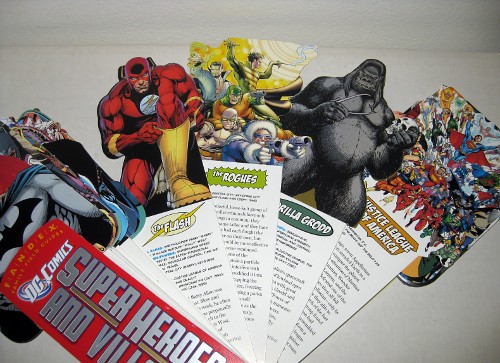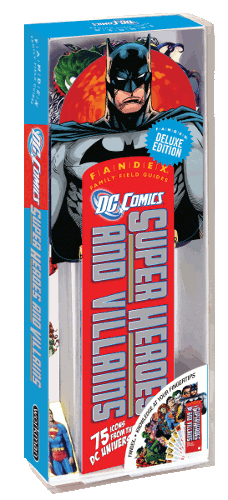Workman’s new DC Comics Super Heroes and Villains Fandex has incredibly detailed information on the DCU’s major characters, but in a format and size that presents a few difficulties.
If you’re not familiar with Fandexes, they’re a series of field guides in the form of cards attached at the base, so that you can swivel any card out and keep it available. You can also open them up as a fan. I first heard of them as nature guides, but they’ve expanded to geography, history, and pop culture.
Wide Coverage
The DC Fandex has surprisingly wide coverage. 75 profiles doesn’t sound like a lot until you consider that it’s comparable to three standard-sized comic books with every page profiling a new character, not unlike the JLA-Z guide that came out around the time of JLA/Avengers. And the text on each card, front and back, is about as long as the classic Who’s Who entries.
They’ve managed to fit in more characters by combining legacies onto a single card. For instance, there’s one card each for Robin, Batgirl, Wonder Girl and Blue Beetle, with the cards profiling the various incarnations of the character. The Flash is simplified to Barry Allen and Wally West, though Jay Garrick and Bart Allen get mentions. On these cards they tend to go for the current version of the character for the image, so Flash is Barry, Robin is Damian Wayne, and Batgirl is Stephanie Brown.
Sometimes it does lead to duplicates. They managed to avoid it with Dick Grayson by profiling him as Nightwing and then picking up the Robin card where it left off with Jason, Tim, etc. But Barbara Gordon gets spotlighted on both the Batgirl and Oracle cards.
One nice bonus: if you were confused about the Monitors’ role in Final Crisis and Superman: Beyond, their card sums it up quite nicely!
Priorities
The guide describes the DCU roughly between Final Crisis and Blackest Night, featuring new versions of heroes such as Batgirl and Robin, and glossing over temporary changes. The Martian Manhunter and Aquaman entries don’t mention their now-reversed deaths, for instance, and Batman’s card focuses entirely on Bruce Wayne, with Nightwing’s card mentioning that Dick has taken over while Bruce was “presumed dead.”
The limited space does lead to some odd choices. With only 75 slots, I don’t think I would have used one on Superboy-Prime. Elongated Man is IMO the more developed of DC’s two “stretchy guys,” but Plastic Man is more well-known, and with Ralph and Sue Dibny dead, I’m surprised they chose to profile them instead of Plastic Man. Maybe it’s the Identity Crisis connection.
It’s a bit tricky to find characters without the index card at the back. There doesn’t seem to be any clear order beyond clustering each major character’s allies, enemies and supporting cast together. For instance, Batman is followed by the Joker, then the other Gotham City heroes, then the rest of the Bat-villains.
Artwork
The cards use existing art, rather than new portraits of the characters, similar to the DC Comics Encyclopedia. A lot of it is recent: Flash is the face-on variant cover from Flash: Rebirth #1, the Rogues are from Salvation Run #1, and Superman is from Superman: Secret Origin #4. Some of it is older: Gorilla Grodd is from the 1990 Who’s Who series. Sources aren’t listed, but the artists are all named on the final card.

Flash Fan’s Perspective
There isn’t a lot of Flash-specific content in the guide. Batman-related characters take up 18 cards, and Superman’s cast gets 13, but there are only three Flash cards: The Flash, the Rogues, and Gorilla Grodd. (The Green Lanterns are also limited to three: one for Hal, one for the GLC, and one for Sinestro.)
The Flash profile covers the highlights of Barry’s and Wally’s careers. Jay Garrick is mentioned only as Barry’s inspiration, though he does get a sentence in the Justice Society profile. Bart gets a sidebar, and there’s a note that Iris II and Jai inherit Wally’s powers. My only complaint about the profile is that in glossing over the details of Barry Allen’s rivalry with Professor Zoom, it implies that Barry killed Zoom when he targeted Iris, rather than when he attacked Barry’s second fiancee Fiona.
The Rogues are a bit of an odd mix, featuring a paragraph each on Captain Cold, Mirror Master, Weather Wizard, Heat Wave, and Abra Kadabra. Okay, so with limited space, they chose five…but why Kadabra, who has never properly been one of the Rogues? (The only time they’ve worked together was in the storyline in which they killed Bart.) Wouldn’t the Trickster have been a better choice? I half-suspect that they picked the Salvation Run image first, then profiled the Flash villains who were on the cover.
On the other hand, with only three cards for Flash characters, at least this way Abra Kadabra gets a profile!
As for the third card, Gorilla Grodd gets a writeup featuring his origin and several major exploits (including turning the Justice League into gorillas during the “JLApe” storyline from about 10 years ago).
Overall
The DC Super Heroes and Villains Fandex packs an amazing amount of information into its small size. The back of the box describes it as “obsessively researched,” and I’m inclined to agree. (And I, uh, know a little something about obsessive research…)
The format has its drawbacks, though. Unless you fold out only one card, it can be awkward to flip from the front to the back. The most frustrating part of it is trying to close up the fan again: the portrait cutouts have a tendency to catch on each other.
And of course the space limitations mean that they only really cover the A- and B-list. If you want to delve further into DC’s extensive world, there are other resources: the DC Encyclopedia I mentioned before, or the new Who’s Who series launching later this year, or the various Secret Files and Origins specials.
If you want a general overview of the DC Universe, the DC Fandex is a good choice. And it’s a lot easier to carry around!
(The publisher provided a review copy.)


I just saw this thing in DC Nation or whatever. Huh! Any Hawkman or Hawkgirl/woman information in there?
.-= Luke’s latest blog post: Hawkman "Retro" Poster =-.
Yes, there’s a Hawkman & Hawlgirl card.
Awesomesauce.
.-= Luke’s latest blog post: Waiting In The Wings — 05/05/2010 =-.
Kelson,
Thanks so much for your review of my Fandex! Hearing you say I made sense of the Monitors makes the whole project worth it.
I can say a lot of thought and consideration went into who was featured in the Fandex and who wasn’t. With the Rogues, you were half right in your half suspicion (I guess that would make you a quarter right, but who’s counting?) I wrote the manuscript before we picked any of the art, and at that time, there were paragraphs on Trickster and Piper (had I any inkling Digger would be back by the end of Blackest Night, he certainly would have been featured). During the editing process, things had to be cut for length… and then we had to find the art. For the Rogues, it was particularly difficult to find an image that suited our criteria. Ultimately we went with the SR image, and I made the decision to add info on Abra since everyone else in the image was described.
In a perfect world, this thing will sell like crazy and we’ll get to make more. I’d love to see an all Flash one with full profiles on Wally, Bart, Max, John Fox, Walter West, and every Rogue who ever committed a crime in the Twin Cities. Heck, the sidebars lend themselves perfectly to the “Flash Fact” heading.
Thanks again for the review. This is meant for the fans as much as newcomers to comics.
Oh, also, that Grodd image is in there because of you. Last September, I posted on Comic Bloc trying to find the origin of the image. You helped ID it, and therefore I was able to track down the Who’s Who and get it scanned. So thanks for that too!
Thanks for stopping by! I’ll definitely be keeping the Fandex handy for quick reference, and I hope you get to do some character-specific sequels.
Funny – I’d completely forgotten that Grodd exchange, but now that you mention it, I remember! Glad I could help!